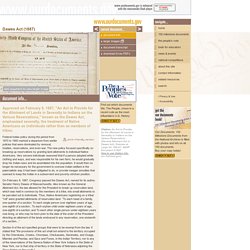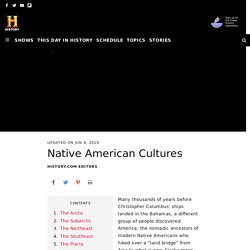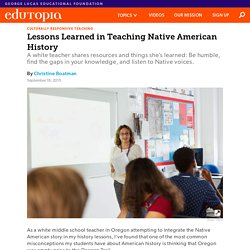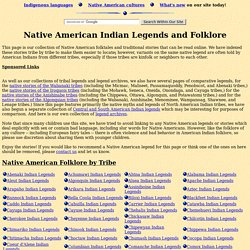

References. Ghost Dance.
Objectives: Explain the significance of the Ghost Dance to Lakota culture. – cmallen3
Quick Tip: Teachers can use this video to help explain " The Ghost Dance". Allowing for students to discourse on this controversial subject. – cmallen3
Dawes Act (1887) Approved on February 8, 1887, "An Act to Provide for the Allotment of Lands in Severalty to Indians on the Various Reservations," known as the Dawes Act, emphasized severalty, the treatment of Native Americans as individuals rather than as members of tribes.
Objectives: Explain the effect the Dawes Act had on Native Americans – cmallen3
Quick Tip: Teachers can use this to access the Primary Resources of the Dawes Act. Created Discussion based on what students believe the Dawes Act enacted. – cmallen3
Federal Indian policy during the period from 1870 to 1900 marked a departure from earlier policies that were dominated by removal, treaties, reservations, and even war.

The new policy focused specifically on breaking up reservations by granting land allotments to individual Native Americans. Battle of the Little Bighorn - Native American History. Sitting Bull and Crazy Horse (c.1840-77), leaders of the Sioux on the Great Plains, strongly resisted the mid-19th-century efforts of the U.S. government to confine their people to reservations.
Quick Tip: Teacher ResourceThis website would educate teachers about objectives 18,19, and 20. It details the battle of Little Bighorn in an article form. There is also a link to videos and a speech that teachers can watch on this page. – cmallen3
Objectives: 1. Describe the consequences of the Battle of the Little Bighorn for the Lakota tribe 2. Identify the leaders in the Battle of the Little Bighorn and explain their importance 3.Explain the significance of the Battle of the Little Bighorn in the conflicts between the U.S. government and Native Americans – cmallen3
In 1875, after gold was discovered in South Dakota’s Black Hills, the U.S.

Army ignored previous treaty agreements and invaded the region. This betrayal led many Sioux and Cheyenne tribesmen to leave their reservations and join Sitting Bull and Crazy Horse in Montana. Native American Cultures - Facts, Regions & Tribes. Many thousands of years before Christopher Columbus’ ships landed in the Bahamas, a different group of people discovered America: the nomadic ancestors of modern Native Americans who hiked over a “land bridge” from Asia to what is now Alaska more than 12,000 years ago.
History.com Editors. (2009, December 4). Native American Cultures. History.com. – cmallen3
Objective: Describe what life was like for Native American tribes before the arrival of Europeans. Quick Tip: Teachers can use this website to help, understand life before European settlement in all parts of the US. – cmallen3
In fact, by the time European adventurers arrived in the 15th century A.D., scholars estimate that more than 50 million people were already living in the Americas.

Of these, some 10 million lived in the area that would become the United States. As time passed, these migrants and their descendants pushed south and east, adapting as they went. In order to keep track of these diverse groups, anthropologists and geographers have divided them into “culture areas,” or rough groupings of contiguous peoples who shared similar habitats and characteristics. The Arctic. North American Indians Portal.
Objectives: 1. Describe the lives of Native American tribes living in the Great Plains, Great Basin, and Northwest Plateau in the early 1800s 2. Describe the lives of Native Americans in the Great Plains in the 1800s 3.Describe the habitat of the Pacific Northwest as a temperate rainforest with an abundance of wildlife and vegetation 4.Explain how Pacific Northwest tribes’ deep connection to their environment was reflected in their culture – cmallen3
Reference: NORTH AMERICAN INDIANS ENCYCLOPEDIA. (n.d.). North American Indians. Encyclopædia Britannica. – cmallen3
Quick Tip! Understanding there are more than one group of indigenous people and picking one group and following their journey as you learn about the trail of tears. Each group of Native Americans had different experiences. This websites gives more insight on the different groups. – cmallen3
What Every Teacher Should know before teaching Native American History.
Objectives: 1. Describe the effect of European settlement on Native Americans – cmallen3
Reference: Morgan, H. (2009). What Every Teacher Needs to Know to Teach Native American Students. Multicultural Education, 16(4), 10–12. – cmallen3
Quick Tip: Teachers need to understand the importance of teaching Native American children. More than likely we have 1 or 2 in our classrooms and don’t even know. Thai article helps give us a different perspective on their views. – cmallen3
Lessons Learned in Teaching Native American History. As a white middle school teacher in Oregon attempting to integrate the Native American story in my history lessons, I’ve found that one of the most common misconceptions my students have about American history is thinking that Oregon was empty prior to the Oregon Trail.
Objectives: 1. Explain how Native Americans’ and pioneers’ ideas of land ownership differed and how this led to conflict. 2.Explain why Europeans immigrated to the New World and moved west 3.Describe and give examples of ways that Native American myths express cultural values, as well as describe natural events 4.Explain how Pacific Northwest tribes’ deep connection to their environment was reflected in their culture – cmallen3
Quick Tip: Use this website as a guide to brush up on important thoughts beyond just teaching Native American History. Think about who your audience is and whose story your telling. – cmallen3
When I think about my students and their visions of covered wagons journeying into a wilderness with “lots of bears and no people” as one of my students said, I can’t help but wonder about how we as educators are teaching (or not teaching) our students about the rich and vibrant history and cultures of Native Americans.

I’ve spoken about this with many educators, and I’ve come to realize the lack of training and resources that teachers have for how to teach Native American history and culture. 7 Ideas for Educators to Consider Before Teaching the Trail of Tears. Osiyo!
Objectives: 1. Explain why Europeans immigrated to the New World and moved west. 2. Explain how Native Americans’ and pioneers’ ideas of land ownership differed and how this led to conflict. – cmallen3
Quick Tip: Thai article gives some teacher “must knows” before you start teaching the Trail of Tears. – cmallen3
That’s hello in Cherokee.

When I started writing Mary and the Trail of Tears, I realized I didn’t know as much as I thought I knew. A lot of research, along with the help and knowledge from other Cherokees, went into helping me tell a story my ancestors would be proud of. I hope these ideas will help you and your students learn about the living descendants of the many Native American people impacted by Indian Removal. Questions will come up that you can’t answer. Native American Legends (Folklore, Myths, and Traditional Indian Stories) Indigenous languages Native American cultures What's new on our site today!
Objectives: Explain that stories told by Native Americans often reflect important values or customs of their culture or way of life – cmallen3
Quick Tips: This website has tons of Native American Tribes Folklores. – cmallen3
This page is our collection of Native American folktales and traditional stories that can be read online.

We have indexed these stories tribe by tribe to make them easier to locate; however, variants on the same native legend are often told by American Indians from different tribes, especially if those tribes are kinfolk or neighbors to each other. Sponsored Links. The Northwest Coastal People - Religion / Ceremonies / Art / Clothing.
Objectives: Describe the religion and important ceremonies that were part of the culture of Pacific Northwest tribes. – cmallen3
Quick Tips: Teachers can access this website to look for important details about ceremonies that were part of the Native American Culture. – cmallen3
America's Great Indian Nations - Full Documentary.
Objectives: Explain how Native American and European ideas of land ownership differed from one another. – cmallen3
Quick Tip: Teachers can use this documentary to gain knowledge on how to explain how Native American and Europeans ideas of land ownership differed. – cmallen3
Carlisle Indian School Project.
Objective: Describe the conditions for Native Americans at “Indian boarding schools” like the Carlisle School – cmallen3
Quick Tip: This is the website to help support and gain an understanding of Indian Boarding Schools like the Carlisle School. – cmallen3